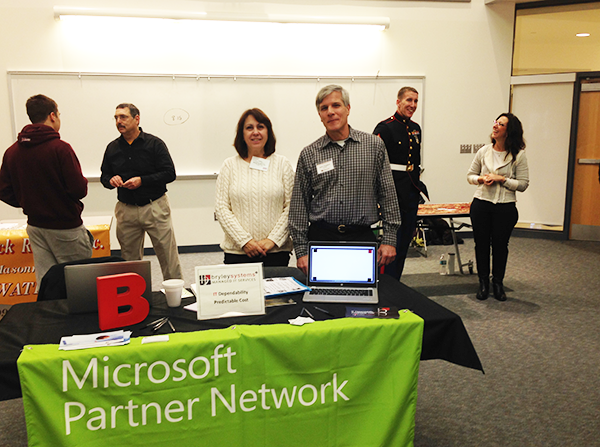Recommended practices – Part 4: Email use
This is a multi-part series on recommended practices for organizations and their end-users. Additional parts will be included in upcoming newsletters.
Email is still the primary business application, although alternatives like texting and social media are gaining ground. Most business people email to clients, prospects, vendors, stakeholders, etc. on a regular basis; they also accept emails from those in the outside world, occasionally with unforeseen consequence.
Organizations should consider email use in these areas:
- Inbound – Email received by the organization’s end-users
- Outbound – Email sent from end-users to others outside the organization
- Etiquette – The appropriateness of the email’s message and content
- Archiving – The ability to store and retrieve historic email
I’ll describe the specifics and offer IT solutions to manage each area.
Inbound email
End-users constantly receive email, usually without incident. However, one misstep in responding can lead to a malware outbreak (or worse). Plus, failing to block inappropriate email content, even unknowingly, can lead to legal repercussions. (For example: An employee could object to receiving an email with explicit pornography and decide to pursue legal recourse.)
Most email-based attacks occur via an attachment; the attachment holds malware designed to activate, usually without fanfare, when the attachment is opened. Often the email message is enticing, in-disguise, or just plain compelling; the end-user believes that opening the attachment is the right thing to do.
Basic rules for opening an email:
- Do not open email from an untrusted source; when in doubt, check it out
- Do not click on an attachment before verifying its integrity
- Always ask for help if uncertain
The best tool is an email-filtering service or device; a service sits outside your organization (Cloud-based) while a device typically sits inside (on-premise).
A Cloud-based, email-filtering service can improve Internet performance by reducing incoming traffic; all emails are captured by the service before they enter the organization’s Internet connection. Some services (i.e.: McAfee SaaS Email Protection and Continuity™ or MEPC) also offer email continuity, which provides the ability to receive and respond to email even when your email server or email service is unavailable. Most email-filtering services are billed monthly on a per-user basis, requiring little or no up-front expenditure.
An on-premise, email-filtering device requires upfront expenditure, but can provide a cost-advantage solution at organizations with many users. To calculate the true cost per user, you would figure the annual cost of the device, add the annual maintenance fee and support costs, and divide by the total number of users.
Both offer advantages; pick one or use both. (We offer McAfee Email Protection and Continuity and our Secure Network™ as service options, but also deploy, on-premise, Barracuda’s Spam Filter, Cisco’s IronPort, and WebSense.)
Outbound email
Outbound email should be secure; you don’t want to expose confidential details to an outsider. However, email is typically sent via open-text format; the contents of the email are unencrypted and can be pieced together by others.
Email typically flows in this fashion:
- Sender composes the email; this might be on a standalone application like Microsoft Outlook or on a web-based interface like Google Gmail.
- Sender sends the email, which ships it to the sender’s email server/service.
- The email server/service addresses the email according to the recipient’s email domain and then forwards it to the email server/service within the recipient’s email domain.
- Email server/service within the recipient’s email domain receives the email, verifies that the recipient exists within this domain, and then forwards the email to the recipient.
- Recipient receives the email.
Email within an organization’s email domain via an internal email server is usually secure; an external email service must be examined to ensure messages are encrypted between the sender, service, and recipient.
Security can be enforced through encryption, which offers levels of enforcement. For example: You can be forced to encrypt any email with the words “social security number”, but not encrypt other emails. Likewise, you can encrypt all email from the Accounting team while not encrypting emails from the Marketing team.
Email encryption is available via external services (we recommend McAfee SaaS Email Encryption™) or through an on-premise device (Cisco IronPort or WebSense).
Email etiquette
You should consider what you are saying and how it might affect the recipient. Even more important, for legal reasons, you should block inappropriate content and malware from being emailed by end-users within your organization.
Outbound policy enforcement and management is available as an external service through McAfee SaaS Email Protection and Continuity, which monitors outgoing email for inappropriate content and malware. Both Cisco IronPort and Websense provide this capability on-premise.
Beyond the basics listed above, email etiquette extends to these areas:
- Sending – Always verify grammar, spelling, courtesy, and content
- Formatting – Don’t type all CAPS; use a white background for readability
- Forwarding – Don’t forward emails unless relevant and desired by recipient
- Attachments – Zip large attachments and virus check before sending
- Privacy – Hide recipients email address when sending to a group
My favorite rules (which I sometimes break):
- Don’t say things in an email that you would not say verbally to the recipient.
- If your email is emotionally tinged, sleep on it overnight before sending.
For tips on email etiquette, please visit http://www.101emailetiquettetips.com/.
Email archiving
Archiving is all about reliable storage and quick retrieval; you never know what you might need to bring back to life or when it will be needed. Saving tens or hundreds of thousands of emails can be challenging; finding the right email can be virtually impossible, but might be required at a moment’s notice.
Archiving can reduce management and storage costs while satisfying e-discovery and compliance requirements. Archiving can also simplify requests for email histories during litigation.
We recommend these archiving options:









